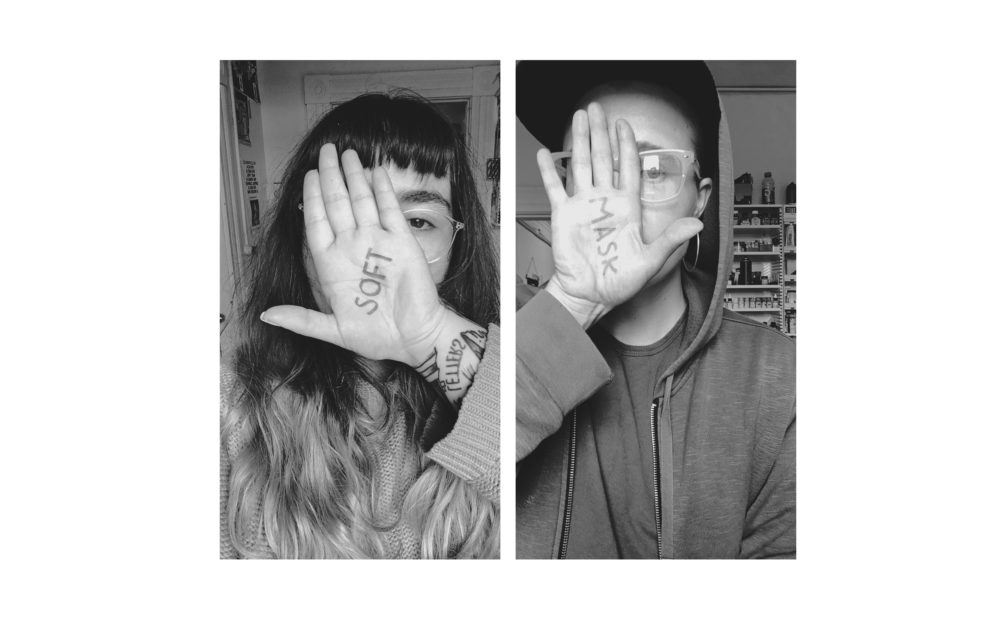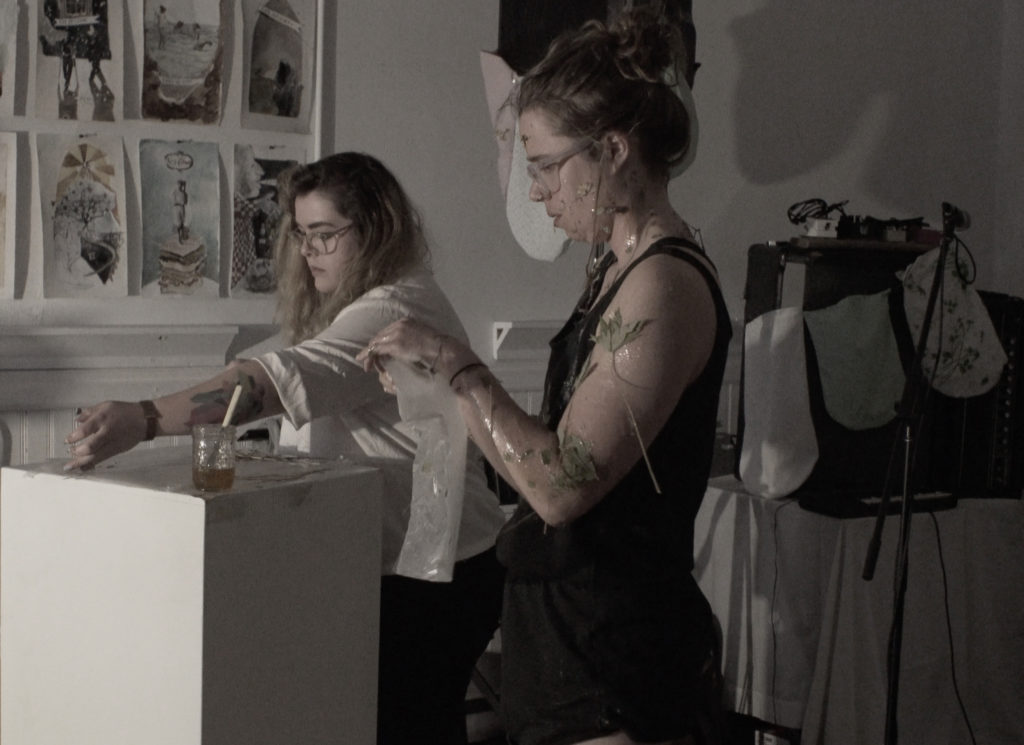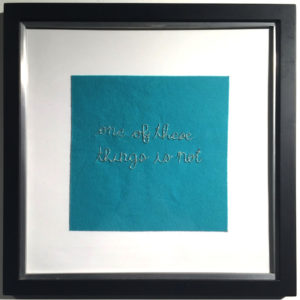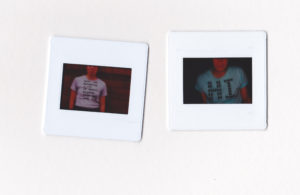A conversation with rudi aker and sophia bartholomew.
Kasie Wilcox @kasie_wilcox | @connexion.arc

rudi aker is a wolastoqiyik queer femme from Sitansisk First Nation. rudi is a multidisciplinary artist exploring language, accessibility, and emotionality – trying to find the conjunction of personal histories and contemporary art. By using work as a navigational tool and engaging with diacritic exposition, rudi aims to both challenge and play with the responsibility of viewership.
sophia bartholomew is a white, able-bodied, non-binary femme based in Fredericton, NB. Having studied contemporary visual art and theory at UBC (Vancouver), as well as having survived physical and psychological forms of trauma, their interdisciplinary projects cycle through performance, language, physical layers, membranes, endurance, protection, genuine care, absurdity, and exhaustion.
rudi and sophia are participating in Limited Time Offer, a pop-up art exhibition and emerging artist-in-residency program hosted by Connexion Artist-Run Centre for Contemporary Art. Connexion ARC’s workspace will be activated into a temporary gallery space for 72-hours only, presenting new works produced by artists-in-residence over the summer months. Limited Time Offer opens on Friday, August 25, and will be on view until Sunday, August 27.
During their residency, rudi and sophia will be developing new sculptural works, under the working title soft mask, unpacking their experiences of care-giving, holding space, and other forms of femme labour — diagramming the soft and invisible architectures that alter both public life and social space.
Kasie Wilcox: Can you describe how this collaboration started?
sophia bartholomew: Well, we’d met several years ago through mutual friends, here in Fredericton, but it wasn’t until last year that we started having some big and real and heartfelt conversations — about art I guess, and also about the intensity of our feelings…
rudi aker: We’d reconnected just as sophia was preparing a performance art piece for Flourish Festival, and wound up collaborating in making that performance, which was so much about emotional labour, or like formulations of protection and care… creating intimacy… yeah, a lot of the same things we’re working on with this project.
KW: Tell us about the project you’re developing during your residency with Connexion.
ra: The project we started working on is called soft mask. Conceptually, it’s a continuation of the discussions that fueled our Bread & Roses performance at Flourish, but this

time around we’ve been experimenting with sculptural objects rather than developing a live performance work. We’ve found a slightly different meeting point between our two practices…
sb: Yeah, making this work still feels very physical, and like embodied, but it also feels more playful. For me there’s definitely a greater sense of safety, working with objects. Like there’s more of a buffer, we’re not negotiating so immediately and so intensely with the people who ultimately receive this work.
KW: Conversation and exchange appear to be a crucial aspect of this project, can you speak to that?
ra: Well, I think conversation and exchange definitely structure our way of working together, in a collaborative process that comes from a place of friendship. Working materially is just another way of talking with each other… and showing this work creates the possibility of extending that conversation to include other people. We’ve talked a lot about using art to create situations of respect and mutual responsibility, reciprocity…
sb: Yeah, we’ve also been considering and kind of responding to the specific space where the work will be shown — that feels like a kind of conversation as well. Like using sculptural elements to alter the codes and signals that already exist in that space.
KW: You will be engaging the public in a workshop to discuss the themes of your project, can you describe what this will look like?
sb: Sure, in this workshop we’ll be working with participants to examine the ways we understand love and care. I think we’ll start by presenting some ideas we’ve each been researching, and talking about together — with a focus on safer space making, care-giving practices, trauma-awareness and healing.
ra: Yeah, basically “Self Care 101: Beyond the Bath Bomb.” (laughs)

KW: You both work as multi-disciplinary artists, and this is true for many contemporary artists. What led you to broadening the boundaries of your practices?
ra: I think that for awhile I’ve been trying to find that juncture between traditional craft — like beadwork, or like knitting — and art, particularly painting. I’ve been trying to figure out how to incorporate all of these things into my practice, because they are all important parts of who I am, and my practice is so much an extension of myself. There was a period of time when I was trying to focus only on painting, and I started to feel really trapped… As a person who is intensely interested in so many things, all of the time, I’m more invested in exploring the broad possibility of art. Like how it’s not about what you use materially, it’s about how you use it. I mean, what’s “art” anyway? Who cares about art? I like to do stuff because it’s nice. I like to keep my hands busy and my head busy.
sb: Yeah I can definitely relate to this. When I showed up at art school in my early twenties, I thought I was going to become an Impressionist painter. Like everything I had learned about “art” up until that point had led me to believe that that was what art was, but… besides having done a lot of drawing and painting growing up, I had also been writing, and making books, doing ceramics, learning about dance and theatre performance. When I started studying contemporary art at UBC, I fought it, like I hated it, but gradually I began to understand that these other modes of expression were as much part of my art practice as the two dimensional work I had been doing. I really connected with work made by artists who were concerned with artist-run space-making and networked exchange — whose practices were oriented towards physical performance, social interaction, and material experimentation.
KW: I’ve noticed that you both incorporate text in your work, when did you individually start to engage language as a part of your artistic practice?
sb: Well, when I moved to New Brunswick five years ago, I was in the middle of working on a performance called make yourself a version of your self, which involved making and wearing a different text-based t-shirt every day for more than a year. I guess that this project was experimenting with the surface or veneer of self-presentation created by both language and clothing, but then the t-shirts also fostered a lot of conversation with friends and with strangers… forcing me to grapple with philosophy, art theory and political ideas in my day-to-day life.
When I look around me, when I listen, I recognize all these different structures that have been made and upheld by language… and I guess for me, language has always felt very material… almost sculptural. Language is just so instrumental in constructing the world we live within, and the things we understand to be true.
ra: I think for me it was…I don’t know, I was doing lot of reading, and writing a lot of poetry — like bad poetry — and out of that, I started to keep a list of all of these things that I thought or said or heard… things that really meant something, or struck a chord somehow. Like I’ve always maintained both a painting and a writing practice, it was just a matter of figuring out how to incorporate those two things together. Like, I really like the absurdity of words, playing with emotional responses to words and phrases… and I find that the words that I use are almost like punch-lines. My work always has to do with emotional intensity, my lived experience of that, and language sometimes feels like the most direct or potent route to take.
Um, yeah another big reason I work through language is like an insecurity, or a disappointment that I have in not being about to speak my Native language fluently. Language revitalization is so big right now, but access to language is definitely still an issue. I’m trying to learn but like in a way that feels true to me, and not in a way where I’m trying to prove something to someone else about my identity. That said, all of the words that I do know are so empowering to me. All of my knowledge within Maliseet is based in translation, some words stick with me, I like to play with that a lot…
KW: I was looking at your artist websites today, and something on your website, sophia, struck me. It’s a phrase on the homepage that says “as soon as i say something it stops being true.” Can you elaborate on this?
sb: Hmm, yeah, that’s an excerpt from a publication I made during a residency at The Khyber called Companions to the Body. I guess… yeah, I guess I was trying to

articulate a feeling of everything being in flux, in movement. How certain things feel very true in one moment, and don’t feel true at all in the next. Or like when I hear my own thoughts spoken out loud, I see the fallacy of them — I’m suddenly more aware of the things that I might be failing to consider…
ra: (laughs) I don’t know, I totally disagree with that statement. Like, I think that of all the many thoughts and feelings that pass through me, continuously, if I’m prompted to say any of them out loud they become true. If you say it, it is a truth.
sb: (laughs)
ra: Yeah, I understand what you mean though… there’s a fluidity of truth, I feel.
Opening and Workshop Information:
Limited Time Offer opens on Friday, August 25. Joins artists and organizers for an opening reception at Sixty-Five York Creative Studio (65 York Street) from 7:00 p.m. – 9:00 p.m. Visit Connexion ARC on Facebook for full details.
A workshop facilitated by rudi and sophia will be held on Saturday, August 26, from 6:00 p.m. — 8:00 p.m., at Sixty-Five York Creative Studio (65 York Street), where they will work with participants to foster self-reflection and development of ideas — discussing inclusivity, safety, mutual support and care for our selves and our communities.
This project is presented with the support of Sixty-Five York Creative Studio and shiftwork collective.
Kasie Wilcox is a New Brunswick-based multimedia artist and director of Connexion Artist-Run Centre for Contemporary Art, in Fredericton, NB. Her practice explores consumer media and services to present artwork, in the forms of books, zines, video, objects, and virtual spaces. Recently she introduced a social dynamic to her work by collaborating with artists, writers, and musicians, to present performances, installations, publications, and a dance party.




